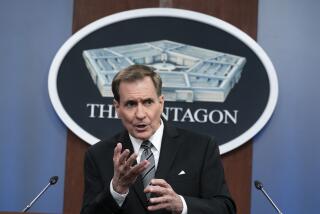Memo Discusses Korean War Strafing
- Share via
WASHINGTON — U.S. pilots fired on columns of fleeing South Korean civilians at the onset of the Korean War, according to an Air Force memo newly unearthed by Army investigators.
The memo, signed by an Air Force colonel, said the Army had requested the strafing because North Korean soldiers in civilian clothing were mingling with refugees and then attacking U.S. troops once they penetrated the American lines.
“The Army has requested that we strafe all civilian refugee parties,” said the memo, which was dated July 25, 1950, signed by Col. Turner C. Rogers and addressed to Lt. Gen. Edward Timberlake, vice commander of the 5th Air Force.
The memo, first disclosed by CBS News, adds one more piece of evidence to a 6-month-old Army investigation of an alleged three-day massacre of civilians at the tiny South Korean hamlet of No Gun Ri that is said to have begun July 26, 1950. New details of the alleged massacre were brought to light last year by Associated Press, but the allegations have become tangled in controversy because of recent indications that some American veterans making the charges were not credible.
Pentagon officials said Tuesday that they don’t question the document’s authenticity but that they had so far been unable to corroborate that U.S. pilots did fire on civilians, as described in the document. They said that because there was no indication where in South Korea these strafing runs took place, there was nothing to tie the memo directly to No Gun Ri.
“We just can’t find any further information that will direct us in a particular direction,” said Navy Rear Adm. Craig Quigley, a Pentagon spokesman.
Several previous pieces of evidence suggest that U.S. forces fired on civilians who were crossing American lines.
Some South Korean civilians have long contended that they were strafed by U.S. planes. Witnesses at No Gun Ri have said they were fleeing such strafing runs when they took shelter under the bridge where they were allegedly fired on by U.S. soldiers.
Though the Air Force memo said U.S. pilots had begun to strafe, it appeared that Col. Rogers was unhappy with the order and was seeking a change in policy from his superior.
While noting that U.S. pilots had “complied . . . to date,” he pointed out that “operations involving the strafing of civilians [are] sure to receive wide publicity and may cause embarrassment to the United States Air Force and to the U.S. government in its relations with the United Nations.”
He appeared to prefer that the Army take care of the job itself.
“It is not understood why the Army is not screening such personnel or shooting them as they come through, if they desire such action,” he wrote. Air Force planes had “more suitable” targets, he said.
Rogers added: “For the protection of the Air Force it is recommended that a policy be established whereby 5th Air Force aircraft will not attack civilian refugees, unless they are definitely known to contain North Korean soldiers or commit hostile acts. It is further recommended that we so inform 8th Army headquarters.”
Leonard Bushkoff, a retired historian formerly with the Historical Division of the Joint Chiefs of Staff, said the memo “seems to be a little more conclusive” indication of official U.S. intentions to attack groups of civilians than the oral accounts of U.S. veterans.
But one Korean War veteran said he found it very difficult to believe that any strafing had taken place.
“To me, it’s unbelievable,” said Sherman Pratt, who commanded an Army infantry company in the conflict and is now judge advocate for the Korean War Veterans Assn. He said that South Korean civilians fled across American lines routinely during the fighting and that U.S. troops knew how to avoid casualties among them.
Associated Press last fall reported the existence of an order from the 1st Cavalry Division calling for the shooting of civilians who crossed American lines.
The memo’s disclosure comes as a dozen Army investigators continue combing through voluminous records on the war at the National Archives. The investigation is politically sensitive, touching on important diplomatic issues between the United States and South Korea.
U.S. officials say there are clear signs that U.S. troops did fire in the direction of Korean civilians at No Gun Ri. Yet there is so far no corroboration of assertions that the shooting was ordered by superiors or that the death toll was several hundred.
More to Read
Sign up for Essential California
The most important California stories and recommendations in your inbox every morning.
You may occasionally receive promotional content from the Los Angeles Times.














